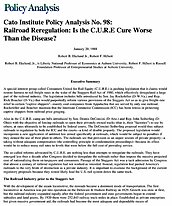Also in the C.U.R.E. camp are bills introduced by Sen. Dennis DeConcini (D‑Ariz.) and Rep. John Seiberling (D‑Ohio) with the objective of forcing railroads to open their privately owned tracks (that is, their “factories”) to use by others, at rates ultimately to be established by federal courts. The DeConcini-Seiberling proposal would thus subject railroads to regulation by both the ICC and the courts–a kind of double jeopardy. The proposed legislation would incorporate a new application of antitrust law aimed specifically at railroads, which would be subject to penalties if they denied the use of their plant to others. The railroads see that provision as an unjust seizure of private property–a taking without adequate compensation (the controlling principle in condemnation proceedings)–because its effect would be to reduce many rail rates to levels that were below the full cost of providing service.
The so-called reforms advocated by C.U.R.E. are nothing less than attempts to reregulate the railroads. They have emerged less than a decade after Congress decided to deregulate the railroads rather than impose the massive projected cost of nationalizing them on taxpayers and consumers. Passage of the Staggers Act was a tacit admission by Congress that almost a century of railroad regulation had not worked as intended. Instead, regulation had pushed America’s railroads to the very brink of destruction as a private industry. It is important to examine the background of the current regulatory proposals because they would likely lead the U.S. rail system down the same track.

